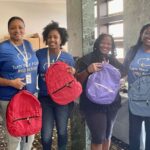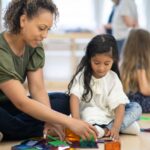Wellpoint and Boys & Girls Club Partnership Proving Successful
The Boys & Girls Club of Greater Milwaukee (BGCGM) and their Social Emotional Development (SED) work was the focus of a visit on October 27, 2022. BGBGM weaves SED throughout their footprint, incorporating SED into the foundation of all their services. Individual Club locations determine the degree to which they embrace SED.
Three tiers of service
BGCGM’s SED approach supports a three-tiered model:
- Tier 3 – youth that need specialized support (e.g., therapy referral, site-based therapy, trauma screening, mental health resources).
- Tier 2 – targeted supports for developing youth social-emotional learning skills (e.g., de-escalation tips, check-ins and screening, comfort kits, social-emotional competencies curriculum).
- Tier 1 – for all, staff development around positive engagement (e.g., ongoing coaching and professional development for staff to use trauma-responsive best practices in their daily work with youth).
SED coordinators run programs at the individual Clubs as well as work with Club staff to build their social emotional and trauma-sensitive skills. Within Tier 3, BGCGM works with Wellpoint Care Network to bring specialized mental health professionals to the Clubs. The program, Project Thrive, is federally funded and offered at eight of BGCGM’s Clubs, removing barriers to accessing care.
It’s all about the kids
Club managers and staff are clear – their work is all about the kids they serve. Club managers, their staff, and the SED coordinators form the front line of BGCGM work. They shared what they are seeing in the youth and families they work with.
What needs are you seeing in families and youth?
- Families need help in speaking about how they are feeling. Youth don’t always have that freedom inside their families. They can speak more freely at the Clubs, where they feel safe. Club managers make themselves available for families and youth to talk to.
- Families need techniques to use when they are emotional. We see families turn to the TV, their phones, etc. as a short-term fix. We help them move away from that to techniques that get at root causes.
- We help families identify that the stressors they experience are a real thing. They don’t always understand this. We strive to help them identify where their anger is stemming from. Then they can address it.
What trends are you seeing in youth behavior?
- All youth have cell phones and that affects how they relate to each other, their teachers, and others. They don’t know how to interact when they aren’t on screen. It is good to have no phone time and make that a norm.
- Youth aren’t able to regulate, they are used to getting on their phones when the feel dysregulated.
- Youths’ attention spans are affected by the instantaneous nature of social media.
- Youth are seeking and have a thirst for connection, particularly one-on-one connection. They need validation.
- We are seeing a lot of trauma in youth.
- It is important to create a safe space for kids so they feel safe enough to take the armor off.
- Youth are speaking and not being heard. Adults are busy, but it is important for youth to have adults ready to talk.
- Talking is fun for youth – they need to be reminded to do that.
What is different now from the pandemic?
- Kids feel safer now, being back in Club. The pandemic had them in a box in front of computer.
- Kids have to relearn how to learn in person from teachers and deal with other kids’ emotions.
- Kids have permission to release after school. They aren’t at home cooking dinner, etc.
What do you find most helpful in meeting youth needs?
- Sensory items.
- Encouraging kids to take a break.
- Being patient and gentle. Lead with compassion. Offer validation.
- Take time for conversations. Youth need to feel heard.
- Have other compassionate adults in the space and on the team. Having people who know youth and care about them. Having youth see the connectedness of adults working together, provides role models for them.
- A lot of our kids don’t have an adult they can go to. They can go to Club staff.
- Social connections.
- Giving kids language to communicate with each other about feelings.
Learn more about the Boys and Girls Club of Greater Milwaukee and their focus on Social Emotional Development.




